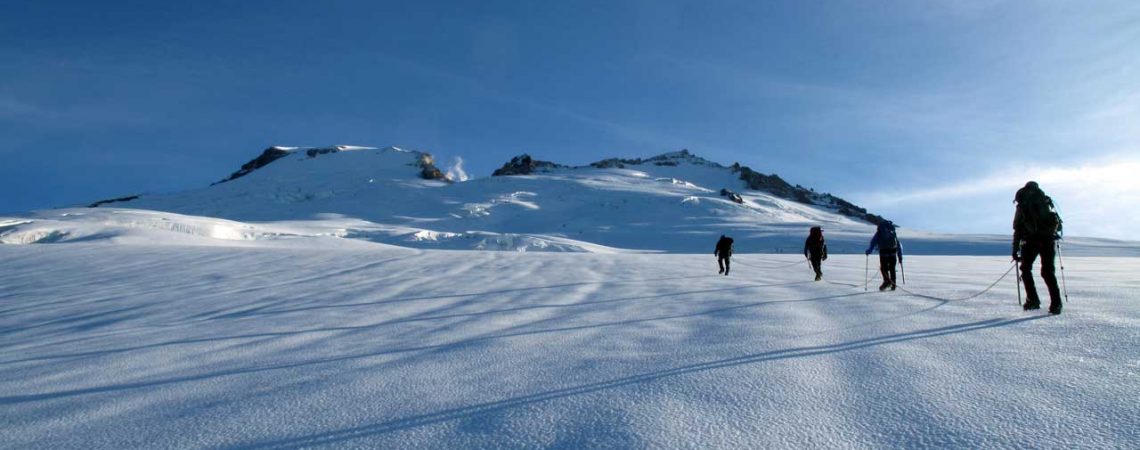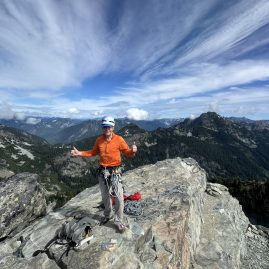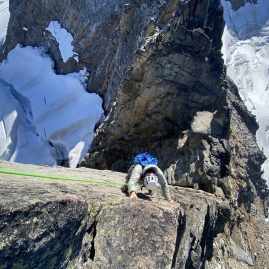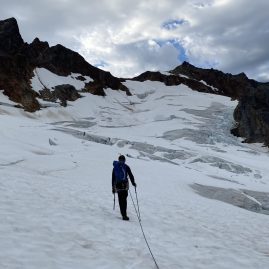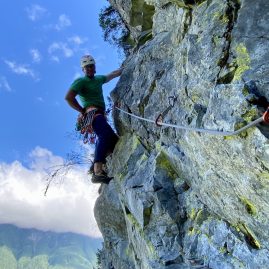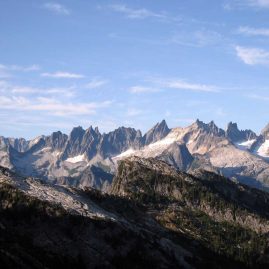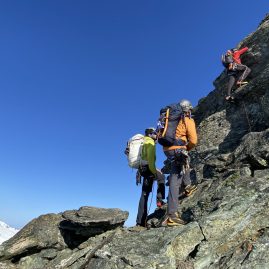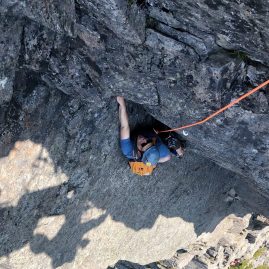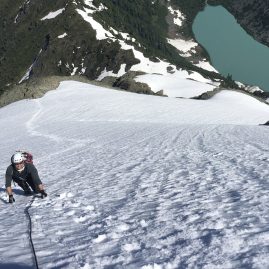Located in the North Cascades, Mount Baker, aka Kulshan-The White Watcher’s fame stems from its accessible, enormous glaciers that climbers gravitate to learn on and challenge themselves whether on the gentle Easton Glacier to the knife edge North ridge. Approaching via the Schrieber’s Meadow, climbers have ample opportunity to practice their glacier mountaineering skills from the comfort of the 6,000′ base camp. From here climbers take in the views of the Twin Sisters Range, Mount Rainier, Mt. Shuksan, and the crest of the North Cascades. The mountain’s abundant alpine terrain make Baker an ideal location to learn snow and glacier travel skills and conditioning in preparation for other Rainier, Denali, Aconcagua, and other high altitude peaks.
- 2 Day Dates:
Custom dates available July-September - 3 Day Dates:
Custom dates available July-September - North Ridge Dates:Custom dates available July-September
- Duration: 1-3 days
- Level: Beginner-Intermediate
- Client Ratio: 2:1- 4:1
- Cost:
- 3 Day– $1095(based on a min of 2 climbers)
- 2 Day– $765 (based on a min of 2 climbers)
- C2C – $850 (based on a min of 1 climber)
- North Ridge/Coleman Headwall – $1450 (based on 2 climbers)
- Included: Guide, group climbing gear, , tent, breakfast & dinner
- Not Included: Transportation, helmet, harness, carabiners, crampons*, ice axe*, boots*, lunch/trail snacks, gratuities for guides and personal camping equipment.
Book 3 Day Online Now!
Book 2 Day Online Now!
Book C2C Online Now!
On this climb we cover:
- Selection and use of personal equipment, ropes, knots & harnesses
- Crampon use & snow climbing techniques, ice axe positioning, and self arrest techniques
- Roped glacier travel, rope team management, route finding, and crevasse navigation
- Hazard assessment including a discussion of objective vs. subjective hazards
- Camp construction, camp management, and cold weather camping skills.
- Discussions will include proper clothing and climbing gear for survival in the high mountains, mountain weather, alpine ecology, and Leave No Trace ethics.
MULTI-DAY ALPINE CLIMBING EQUIPMENT LIST
Our recommended clothing system has four layers.
- Base layer: manages moisture and wicks perspiration away from your skin. (synthetic or merino wool)
- Softshell: should be a durable, comfortable, insulating and wind/water resistant layer that breathes well.
- Hard shell: windproof, waterproof and breathable. (e.g. Gore-Tex, or similar)
- Insulating layer: should be down-fill or synthetic-fill and fit over all layers. (e.g. down, primaloft or polarguard)
These four layers are usually sufficient for most people, but if you tend to be colder bring one extra medium-layer that would be ideal for extra warmth around camp, such as a vest. When deciding what to pack, remember to bring enough clothes and accessories to ensure your safety and comfort, while not over-burdening yourself with items you probably won’t use.
Climbing Gear
- Adjustable Ski Poles
- Alpine Climbing boots Full shank crampon compatible leather, synthetic, or hybrid boot depending on climb and season.Single-weight synthetic/leather mountaineering boots are adequate for mid and late-summer climbs on Mount Baker and in the North Cascades when conditions are expected to be dry.
- Alpine climbing harness Must have adjustable leg loops and fit over all clothing and can be put on with ski boots
- Ice Axe – Lightweight
- Crampons with anti-ball plate Must be fit to boots prior to trip,
- Climbing/ski helmet Adjustable, should fit with hat on
- 2 locking carabiners – 2 Large, pear-shaped carabiner is best, screw gate type recommended and 2 smaller locking screwgate
- 1 single length sling
- Crevasse Rescue Equipment Kit optional*:
- 4 locking carabiners – 2 Large, pear-shaped carabiner is best, screw gate type recommended and 2 smaller locking screwgate
- 4 regular carabiners (e.g. small wire gate are recommended)
- 1 double length sling
- 1 single length sling
- ! Cordelette 6 mil 18-20’(6-7 meters)
- 1 12” Prussik or Hollow Block*
- 1 Microtraxion & Tibloc*
Upper Body
-
- Lightweight base layer T-shirt or long sleeve polypropylene shirt
- 2 synthetic sports bras*(WOMEN)
- 1 long sleeve Sun Hoodie Lightweight, light colored for sunny days
- Soft Shell
- 1 Down/synthetic jacket with hood
- 1 Hard shell jacket with hood Waterproof and breathable. roomy enough to fit over multiple layers.
- 1 pair liner gloves Thin wool or polypropylene
- Shell gloves or mitts
- Warm hat Wool or synthetic
- Balaclava or Buff
- Shade hat or baseball cap
Lower Body
- 2 heavy wool/synthetic socks Check boot fit with liner and wool socks on
- 1 pair lightweight long underwear Polypropylene or Capilene
- 1-2 pairs of underwear boxers/briefs
- Soft shell pants
- Shell pants Waterproof/breathable with full side zips
Sleeping Gear
- Sleeping bag Rated to at least 20º F. Line the stuff sack w/ plastic bag.
- Sleeping pad 1 closed cell foam and/or Neo-Air for extra warmth and comfort.
Backpack
- Internal frame pack 3500-4500 cubic inch capacity able to carry snowboard/skis
Miscellaneous Equipment
- Sunglasses 100% UV protection with side shields or wrap around.
- Personal first aid repair kit Basics: moleskin/blister kit, Band-Aids, first-aid tape, ibuprofen, personal medications, and batteries etc.
- Lip balm At least SPF 20
- Sunscreen At least SPF 40
- Headlamp lightweight LED
- 2 water bottles 1 liter wide-mouth Nalgene and 1 bottle holster, or
- Hydration bladder With drinking tube and 1 Nalgene bottle
- Bowl and spoon Plastic, small Tupperware works well. Lexan spoons are best.
- Toiletry kit Be sure to include WAG Bag or toilet paper stored in a plastic bag.
- Bandana
- Hand wipes
- Favorite snack foods (no more than 2 pounds)
Day 1: Hike to Camp 2,600′ ↑ , 3.5 ~ Miles, 3-4 hours
Drive from Seattle to the trailhead at Schreiber’s Meadow (3,200 feet) on the south side of Mt. Baker. Approximate driving time is 2.5 hours. The hike to base camp at 6,000 feet takes about 3 to 4 hours. We will travel through lush ancient forests, high alpine meadows, and snow covered areas en route to our high camp. After setting up camp, we will perform an equipment check and skills assessment. We spend the afternoon learning the essentials of glacier travel; ice axe / crampon use, self arrest, rope team travel and basic hazard assessment. The remainder of the evening is spent making final preparations for the next day’s summit attempt.
Day 2: Summit Climb 4,780′ ↑ 4,780‘↓, 7 ~ Miles, 9-12 hours
The second day begins early with an alpine start followed by a quick breakfast – Typically between 2 and 3 a.m. is our start time for the climb. Depending on conditions and the pace of your group, it takes from 5 to 7 hours to reach the top. Gorgeous views of the North Cascades reward you as you stand on the summit of the North Cascades’ highest volcano. We return to base camp by early afternoon and you will enjoy an early evening celebratory dinner before getting some well needed rest.
Day 3: 2,600‘↓, 3.5 ~ Miles, 2-3 hours
After a relaxing breakfast we break down camp, and descend to our vehicle. Plan to be back in Seattle by 4-7 p.m.
NOTE: Depending on weather conditions, your group may summit on the third day of the itinerary. This contingent makes for a long day making your arrival time in Seattle later in the evening, often by 9-10 p.m.
Day 1: 2,350′ ↑ 3 ~ Miles, 3-4 hours
Drive from Seattle to the Heliotrope Ridge trailhead (3,700 feet) on the North side of Mt. Baker. Approximate driving time is 3 hours. The approach to base camp at 6,000 feet takes 3 to 4 hours. We will travel through lush ancient forests, high alpine meadows, and snow covered areas en route to our high camp. After setting up camp, we will perform a skills assessment. We spend the afternoon learning the essentials of of glacier travel; ice axe / crampon technique, self arrest, roped team travel, route finding, and hazard assessment. The remainder of the evening is spent making final preparations for the next day’s summit attempt.
Day 2: 4,750′ ↑ 7,100′↓, 10 ~ Miles, 10-13 hours
The second day begins early with an alpine start followed by a quick breakfast – typically between 2 and 3 a.m is our start time for the climb. Depending on conditions and the pace of the group, it takes from 5 to 7 hours to reach the top. Gorgeous views of the North Cascades reward you as you stand on the summit of the North Cascades’ highest volcano. We return to base camp by early afternoon. After a brief rest, we break down camp, and descend to our vehicle. Plan to be back in Seattle by 6-7 p.m.
Day 1: 2,350′ ↑ 3 ~ Miles, 3-4 hours
Drive from Seattle to the Heliotrope Ridge trailhead (3,700 feet) on the North side of Mt. Baker. Approximate driving time is 3 hours. The approach to base camp at 6,000 feet takes 3 to 4 hours. We will travel through lush ancient forests, high alpine meadows, and snow covered areas en route to our high camp. After setting up camp, we eat a big dinner and head to bed early.
Day 2: 4,750′ ↑ 7,100′↓, 10 ~ Miles, 10-13 hours
The day begins with an alpine start – usually between 1 and 2 a.m.
North Ridge: The standard start crosses a double bergshrund and then goes up a broad gulley feature of 40 degree snow. Straightforward glacier travel on the central ridge section steepens into ice slopes that lead up to the base of the prominent ice cliff spanning the bulk of the north face. As the angles steepen we’ll start belaying and then climb, in a classic and exposed position, directly up the ice cliff in a few short pitches (60-80 degrees). Beyond this it’s more glacier travel, some short and steep traverses, and the final summit plateau.
Coleman Headwall: Our route travels up the right-center of the Coleman Glacier, weaving around large crevasses to the base of the Headwall proper. The climbing starts on moderate (40°-50°) snow and ice slopes with the occasional short, steep ice section (~70° to near vertical). Depending on the line taken, the middle of the route consists of a very aesthetic ice arête, or long moderate snow and ice slopes broken by big crevasses. The final ice face is one of Baker’s most beautiful features and is broken by a large bergshrund that can provide steep and exciting climbing.
Depending on conditions and the pace of the group, it takes from 8 to 12 hours to reach the top. Gorgeous views of the Cascades reward you as you stand on the summit of the North Cascade’s highest volcano. We descend via the standard Coleman-Deming route, down the Roman Wall to a saddle between the Black Buttes and Baker’s summit, and onto the lower Coleman and our camp.
Day 3:
Day 3: 2,600‘↓, 3.5 ~ Miles, 2-3 hours
Break down camp and descend to the trailhead. Alternatively, and for those wanting to sample more of the great alpine ice climbing on the Baker’s north side, we could do a few hours of seracing on the lower Coleman Glacier to round out a full trip.
WILL MY GUIDE (OR GUIDES) BE?
You will receive an introductory email with the instructor for your course. We are small company who enjoy working together in the mountains as well as highly skilled professionals who hold current Wilderness First Responder certification and are proficient in technical rescue and evacuation skills. Our guides are dedicated to the world of alpinism, many having first ascents and hold professional certifications with AIARE & AMGA. The AMGA is part of the IFMGA, which is the international body of certified mountain guides.
HOW MUCH SHOULD I TIP MY GUIDES?
Tipping is considered standard practice in the guiding industry. Tipping amounts vary – so $20-30 per day per person/per guide is average that works well for the guides without a serious blow to your wallet. Often 10% of the course cost is a good rule-of-thumb. If you feel that the program was exceptional or substandard the tip can reflect that.
CAN I RENT EQUIPMENT FROM BCAG?
No, we recommend renting from Cripple Creek where they have a full selection of rentals.
HOW HEAVY WILL MY PACK BE?
You will carry 30-40 pounds, which will include everything on the equipment list.
WHEN DO I NEED TO PAY THE BALANCE OF MY TRIP?
For Scheduled Domestic Courses and Climbs: Your balance is due 21 days from trip departure.Payable when you make your reservation by check, or credit card.
WHAT HAPPENS IF I NEED TO CANCEL MY TRIP?
If you should decide to cancel your trip, BCAG must be notified in writing. Your trip will be cancelled from the date we receive written notice. You will be assessed a cancellation fee according to the following schedule:
90 to 22 days from trip departure – 50% of trip cost
30 days or less – 100% of trip cost
WHAT HAPPENS IF I WANT TO CHANGE THE DATES OF MY TRIP?
Schedule changes are subject to a $50 fee per person up to 2 weeks out and $100 less then 14 days from the start of the trip and may not be possible. If conditions or circumstances preclude running a scheduled program we reserve the right to make the decision as to whether the program will be canceled, rescheduled, or an alternative provided.
WHAT HAPPENS IF BC ADVENTURE GUIDES HAS TO CANCEL MY TRIP?
In the rare circumstance where we need to cancel a program you can reschedule without a fee or receive a refund on your deposit. If circumstances arise that force us to cancel a program that is already in progress we reserve the right to decide whether a refund or credit, at a prorated rate, will be issued. We are not responsible for cancellation fees or costs arising from your changed or cancelled flights, lodging, or other arrangements. We strongly recommend obtaining trip cancellation insurance from your travel agent.
DO I NEED TO PURCHASE TRIP INSURANCE?
BCAG highly encourages the purchasing of trip cancellation and travel insurance on domestic trips and requires it on international trips. Europeans and Canadians use it because travel insurance provides coverage for trip cancellation and interruption, travel delays, loss of baggage and travel documents, baggage delays, medical expenses and emergency assistance. To avoid any financial hardship that an unexpected cancellation or interruption could cause,
Trip Cancellation/Interruption costs about 5% of your trip cost and it’s worth the peace of mind! If you find that you are not already covered for any of the above circumstances you have options!
BCAG has an account with Global Rescue, the world’s leading membership organization providing integrated medical, security, travel risk and crisis response services to our travelers worldwide. They can provide you with medical and evacuation coverage.
https://partner.globalrescue.com/bcadventureguides/index.html
WHEN SHOULD I PLAN TO LEAVE A RETURN HOME?
We often get this question because most people need to know how much total time they need to take off work. Our Northwest trips begin at 6-7 am in Seattle on the first date of your trip. Therefore, you will want to arrive the day before your climb or course begins. Our return to Seattle on the last day typically extends into the early evening with the descent and drive back. We suggest you make a hotel reservation for the night of the last day or a late red eye flight to return home on the day following the end of your course or climb.
WHAT IF I WANT TO ARRIVE EARLIER OR DEPART LATER THAN THE TRIP DATES?
No problem. There is a lot to see and do in the Seattle area and we would be happy to recommend our favorite attractions, restaurants, and day trips.
WHERE SHOULD I STAY IN SEATTLE?
There are many other hotels nearby to choose from as well and suggest one that includes parking and possibly north of downtown.


